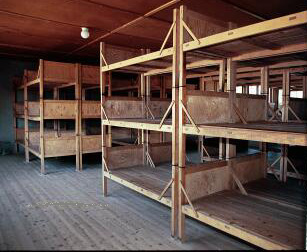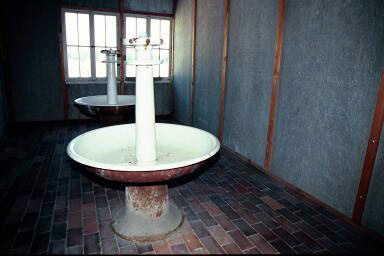Interior of the Dachau barracks"In the normal pattern, the main entrance gave access to two apartments, each containing a living-room and a dormitory. Forty-five wardrobes lined the walls of the living-room, one for each prisoner. There was the same number of chairs and four tables. There were forty-five beds in the dormitory, one row of beds above the other. They were arranged so that they could accommodate ninety persons, the prisoners of two apartments." Dr. Johannes Neuhäusler, What Was It Like in the Concentration Camp at Dachau.  By 1937, the new barracks in the Dachau concentration camp had been completed. They were a far cry from the old barracks which had been the worker's quarters in the old gun powder and munitions factory which was converted into a concentration camp on May 22, 1933. The new barrack buildings at Dachau were 330 feet long by 33 feet wide. They were arranged on each side of the main camp road that was 990 feet long and 99 feet wide. Everything was precisely measured and aligned. Each building, or block as they were called, was divided into two sections. A separate door for each section opened from the outside into a tiny hallway. Straight ahead were the two doors into separate rooms for the toilets and the wash basins. On each side of the entrance hallway were the living rooms with wooden lockers against the walls and tables for eating, as shown in the photograph above. Notice the abundance of windows. The floors were bare, unpolished wood. Each living room had 45 lockers, one for each prisoner, with four tables and 45 stools for eating. The prisoners were required to keep the barracks very clean and orderly. A sign in the reconstructed barrack says that the prisoners had to remove their shoes before entering. The beds had blue and white checkered covers which had to be lined up precisely when the bed was made. The lockers had to be kept neat with everything in its specified place. If any prisoner was found to have a messy locker, the contents were thrown out, and the prisoner had to forego dinner while he cleaned the inside of the locker with sand paper. After the war, Paul Berben, an inmate at Dachau wrote a book entitled "Dachau 1933 - 1945: The Official History." According to Berben's book, the Nazis considered strict hygiene to be vital in keeping the prisoners alive and able to work. He wrote that "The newcomers went to the showers, were cropped, given clothes and underwear, wretched, it is true, but laundered." Berben maintained that, in the early years, the rooms were not overcrowded and that the prisoners realized that strict rules had to be adhered to. Berben wrote that the "when hygienic precautions were laid down, it was merely to protect the S.S. staff and to have the maximum labour force." When the 30 barrack buildings were finished in 1937, the new "model camp" was large enough to accommodate only 5,000 prisoners. By that time, the Nazis had been in power for four years, and they had complete control of the population. Their political enemies had been largely eliminated and the Final Solution of the Jewish Question had not yet been planned. These barracks were built to last for 10 years, by which time the Nazis anticipated that they would no longer need concentration camps for their political opponents. Each of the 30 barracks was designed to accommodate 180 prisoners with 90 men in each section. There were two living rooms and two dormitory rooms in each section. Each dormitory room had 15 three-tiered bunks with a total of 45 beds.  Soon after the "model camp" was finished, the situation in Germany began to change rapidly. In November 1938, there were 10,911 Jews brought to the camp after the pogrom known as Kristallnacht. They were released only if they agreed to sign over all their property to the Nazis and leave the country. It was difficult for the Jews to find a country that would take them, so some of them remained at Dachau up until 1941. Earlier in 1938, after Austria became part of the Greater German Reich, and what is now the Czech Republic became a German protectorate, anti-Nazi political prisoners, including some Jews, were brought to Dachau from those countries. In 1940, nearly a year after Poland had been conquered in September 1939, a large number of Polish resistance fighters were brought to Dachau. Polish citizens were also brought to Germany as forced laborers and by the time that Dachau was liberated, the majority of the prisoners were Polish. Throughout the war years, the largest number of prisoners at Dachau were Polish Catholics. After 1942, although no additional barracks were ever built, the prison compound had at least 12,000 prisoners, who had to live in barracks designed for only 5,000 men.    Classification of PrisonersPreviousBack to Dachau Concentration CampBack to Table of ContentsBack to Dachau indexHome |